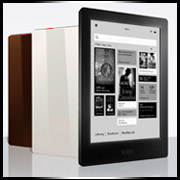
Kobo on Monday introduced the Aura HD, an e-reader that sports some high-end touches such as a one-month-plus battery life.  Other features that set the Aura HD device apart from other e-readers in the market include a high- resolution E Ink display and a 6.8-inch screen designed to look and feel more like a book.
Other features that set the Aura HD device apart from other e-readers in the market include a high- resolution E Ink display and a 6.8-inch screen designed to look and feel more like a book.
The Aura HD, which retails for US$169.99, became available for pre-order on Tuesday on the Kobo site.
High-End Specs
Kobo Aura HD also is equipped with special technology that directs light at the page instead of in the reader’s eyes and a 1 GHz processor that Kobo claims is 20 percent faster than that of other e-readers.
It has 4 GB of storage to support 3,000 e-books and offers expandable memory of up to 32 GB. There is also WiFi connectivity.
Finally, the company is debuting a social reading platform called “Reading Life” with the Kobo Aura HD. It is a platform to share thoughts about books, as well as track reading stats and other statistics on the reader’s Facebook timeline.
Waiting for the End of E-Readers
The Kobo Aura HD may seem like a foolish endeavor to anyone who’s become enamored with the tablet form factor and functionality. “Why would anyone want to invest in another device if you’re going to carry around a tablet as well?” goes the thinking.
This argument certainly resonates with a segment of the gadget-buying population, but it ignores the peculiar likes and dislikes of the hard-core reader, who may spend hours with the device and will appreciate the reading-specific features.
“It is true that more people are selecting tablets because they are multifunctional, but e-readers will not be rendered completely obsolete, James Brehm, senior strategist and consultant with Compass Intelligence, told TechNewsWorld.
“I wouldn’t say it will be a strong niche or standalone technology, but it is not going anywhere,” he reiterated.
The price point will remain a factor, he said. “I think it will be a gut check for many consumers, especially if they know they will be using the device only for reading.”
Many respondents to a survey Brehm conducted said they planned to buy a tablet to replace an e-reader.
“Their responses say that they will make the switch,” he said, “but the evidence shows that they are still buying [e-readers].”
Combined with the e-reader’s special features, said Brehm, the price differential between the tablet and the e-reader is enough to keep the sector going. -end-





















































Uhm.. Still waiting on color e-ink screens. Until then, the thing could last 4,000 years, and it would still just be another damned Kindle. And, no, LCD isn’t an option, since the whole point of longer battery life, and, well.. better survivability under stress, and readability, is to get away from LCD, back-lights, etc,